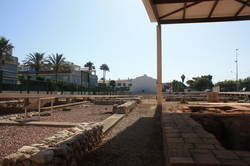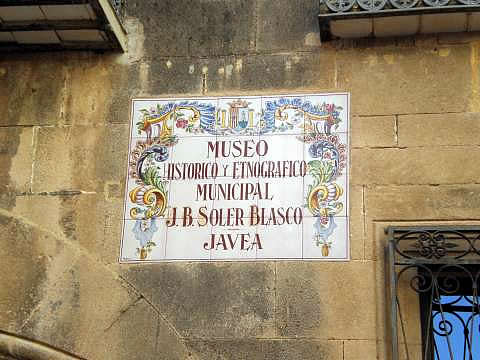|
“WEDNESDAYS FOR THE CURIOUS”
The first in an irregular series of informal talks and tours in the Museum of Xàbia Wednesday 30 October 2013 at 19:00 in the Museum Marine archaeology in Xábia led by Joaquim Bolufer, Xàbia’s Muncipal Archaeologist Director of the Museum of Xàbia and President of the Amics del Museu de Xàbia. Our recent visit to the excavations in Els Poblets of a Roman ‘factory’ for making amphores brought to life the Roman artefacts displayed in our Museum. Amphoras, ceramics of every type, anchors of stone, lead or iron and remains of vessels have been found in several places on our coast. The extremely favourable location and unique geographic characteristics.of Xàbia has been responsible for its ancient and long history of commercial contacts with many places in the Mediterranean and other areas. Ximo Bolufer will put them in context and elaborate on the Roman period locally. Stay and enjoy a drink and an informal chat afterwards English (and German) translation available courtesy of AMUX members Limited places. Register now with membership no. at [email protected] o al Museu
0 Comments
 Special guided visit for AMUX members and guests to L'ALMADRAVA ROMAN EXCAVATIONS and TORRE DE MIRARROSA IN ELS POBLETS Saturday 5 October 2013 Depart: 09:30 from Parking Avenida de Palmela Transport: Shared cars to minimise transport costs Duration: About 3- 4 hours, including journey Guide: Josep A. Ahuir Dominguez, archaeologist Language: Information sheets available in English, as well as Castellano Prompted by our very enjoyable Roman Supper in June, the AMUX has organised a special guided visit to the fascinating Roman excavations in Els Poblets and the nearby 15th century Torre de Mirarrosa, which is not normally open to the public. The Roman site at L'Almadrava was an ancient pottery factory, where tiles and amphorae were made. The amphorae were used as disposable containers for the transport of local wine, olive oil and salted fish. Visible in the excavations are the places where clay was stored, the kilns and the porches where the amphorae were dried, as well as workshops and the workers' quarters. Alongside, part of a building has been discovered with all the signs of a nobleman's home. The nearby Torre de Mirarrrosa was built in the 15th century to defend the town and control access over the river Girona. Standing approximately 11 metres high, it has three floors. It is not normally open to the public. REGISTRATION requested Please indicate if seats available in your car for other people or if you need transport Email: [email protected] or leave your name at the Museum reception. |
ACTIVITIES
Categories |
- Home
- Blogs
-
Projectes
- Premio de Investigación - Formularios de Inscripción
-
Traducciones Translations
>
-
DISPLAY PANELS - GROUND FLOOR
>
- THE STONE AGES - PALAEOLITHIC, EPIPALAEOLITHIC AND NEOLITHIC
- CAVE PAINTINGS (ARTE RUPESTRE)
- CHALCOLITHIC (Copper) & BRONZE AGES
- THE IBERIAN CULTURE (THE IRON AGE)
- THE IBERIAN TREASURE OF XÀBIA
- THE ROMAN SETTLEMENTS OF XÀBIA
- THE ROMAN SITE AT PUNTA DE L'ARENAL
- THE MUNTANYAR NECROPOLIS
- ARCHITECTURAL DECORATIONS OF THE PUNTA DE L'ARENAL
- THE ATZÚBIA SITE
- THE MINYANA SMITHY
- Translations archive
- Quaderns: Versión castellana >
- Quaderns: English versions >
-
DISPLAY PANELS - GROUND FLOOR
>
- Catálogo de castillos regionales >
- Exposició - Castells Andalusins >
- Exposición - Castillos Andalusíes >
- Exhibition - Islamic castles >
- Sylvia A. Schofield - Libros donados
- Mejorar la entrada/improve the entrance >
-
Historia y enlaces
-
Historía de Xàbia
>
- Els papers de l'arxiu, Xàbia / los papeles del archivo
- La Cova del Barranc del Migdia
- El Vell Cementeri de Xàbia
- El Torpedinament del Vapor Germanine
- El Saladar i les Salines
- La Telegrafía y la Casa de Cable
- Pescadores de Xàbia
- La Caseta de Biot
- Castell de la Granadella
- La Guerra Civil / the Spanish civil war >
- History of Xàbia (English articles) >
- Charlas y excursiones / talks and excursions >
- Investigacions del museu - Museum investigations
- Enllaços
- Enlaces
- Links
-
Historía de Xàbia
>
- Social media
- Visitas virtuales
- Tenda Tienda Shop


 RSS Feed
RSS Feed
